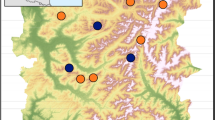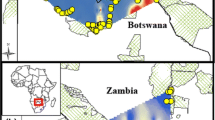Abstract
The use of a quantitative population growth model to investigate the persistence of South African elephant populations is explored. The model provides quantitative assessments of population persistence and confidence intervals for estimated parameters based purely on population size estimates. The analysis supports the view that most of the larger populations in the region are secure. This view is further supported by a lack of density dependent effects in most of the recovering populations and the high population rates of increase observed. This predominantly positive prognosis is in contrast with that emerging from most of the rest of the African continent where the populations are under greater threat because of habitat restriction and direct human conflict. This preliminary assessment of elephant population persistence suggests that “viable” populations may lie between 400 and 6000 individuals. Although not inconsistent with information-greedy genetic and demographic models, the relationship between population growth versus genetic and demographic models should be further investigated. The implementation of a metapopulation management strategy towards these smaller populations is advocated. In addition, as all of the populations included in this analysis have been afforded some degree of protection since the 1920s, continued protection would be a prerequisite for their continued survival.
Similar content being viewed by others
References
Anon, A Proposal for the Transfer of South Africa's African Elephant Population (Loxodonta africana) from Appendix I to Appendix II (National Parks Board, Pretoria, 1994).
P. Armbruster and R. Lande, A population viability analysis for African elephant (Loxodonta africana): how big should reserves be?, Conserv. Biol. 7 (1993) 602–610.
M.S. Boyce, Population viability analysis, Ann. Rev. Ecol. Syst. 23 (1992) 81–506.
M.P. Burton, Alternative projections of decline of the African elephant, Biol. Conserv. 70 (1994) 183–188.
G. Caughley, Directions in conservation biology, J. Anim. Ecol. 63 (1994) 215–244.
G. Caughley, H. Dublin and I. Packer, Projected decline of the African elephant, Biol. Conserv. 54 (1990) 157–164.
D.H.M. Cumming, Wildlife Conservation in African Parks: Progress, Problems and Prescriptions (World Wildlife Fund Multi-Species Project, Harare, 1990).
B. Dennis, P.L. Munholland and J.M. Scott, Estimation of growth and extinction parameters for endangered species, Ecol. Monogr. 61 (1991) 115–143.
B. Dennis and M.L. Taper, Density dependence in time series observations of natural populations: estimation and testing, Ecol. Monogr. 64 (1994) 205–224.
D.F. Doak and L.S. Mills, A useful role for theory in conservation, Ecology 75 (1994) 615–626.
H.T. Dublin, T. Milliken and R.F.W. Barnes, Four Years after the CITES Ban: Illegal Killing of Elephants, Ivory Trade and Stockpiles (IUCN/SSC African Elephant Specialist Group, Nairobi, 1995).
P. Foley, Predicting extinction times from environmental stochasticity and carrying capacity, Conserv. Biol. 8 (1994) 124–137.
I.R. Franklin, Evolutionary change in small populations, in: Conservation Biology: An Evolutionary-Ecological Perspective, eds. M.E. Soulé and B.A. Wilcox (Sinsauer Associates, Sunderland, MA, 1980) pp. 135–150.
K.J. Gaston and A.O. Nicholls, Probable times to extinction of some rare breeding bird species in the United Kingdom, Proc. Roy. Soc. London 259 (1995) 119–123.
N. Georgiadis, personal communication; Mpala Research, P.O. Box 555, Nanuki, Kenya.
N. Georgiadis, L. Bischof, A. Templeton, J. Patton, W. Karesh and D. Western, Structure and history of African elephant populations: I. Eastern and Southern Africa, J. Heredity 85 (1994) 100–104.
M. Gilpin and I. Hanski, eds., Metapopulation Dynamics: Empirical and Theoretical Investigations (Academic Press, London, 1991).
A.J. Hall-Martin, Distribution and status of the African elephant Loxodonta africana in South Africa, 1652–1992, Koedoe 35 (1992) 65–88.
K. Kangwana, Human-elephant conflict: the challenge ahead, Pachyderm 19 (1995) 11–14.
M.H. Knight, A.S. van Jaarsveld and A.O. Nicholls, Evaluating persistence in fragmented South African elephant (Loxodonta africana) populations: conservation and management implications, in: Proc. Elephant Management and Owners Association (EMOA) Workshop, Warmbaths, 1995, ed. M. Garai (Bedfordview, South Africa, 1995) pp. 76–86.
R.C. Lacey, VORTEX: a computer simulation model for population viability analysis, Wildlife Res. 20 (1993) 45–65.
R. Lande, Genetics and demography in biological conservation, Science 241 (1988) 1455–1460.
R.M. Laws, I.S.C. Parker and R.C.B. Johnstone, Elephants in Their Habitat (Clarendon Press, Oxford, 1975).
R.M. May, The role of ecological theory in planning re-introduction of endangered species, Symp. Zool. Soc. London 62 (1991) 145–163.
A.O. Nicholls, P.C. Viljoen, M.H. Knight and A.S. van Jaarsveld, Evaluating population persistence of censused and unmanaged herbivore populations from the Kruger National Park, South Africa, Biol. Conserv. 76 (1996) 57–67.
H.R. Pulliam, Sources, sinks, and population regulation, Am. Nat. 132 (1988) 52–661.
M.E. Soulé, ed., Viable Populations for Conservation (Cambridge University Press, Cambridge, 1987).
C.A. Spinage and F.E. Guiness, Tree survival in the absence of elephants in the Akagera National Park, Rwanda, J. Appl. Ecol. 8 (1971) 723–728.
B.H. Walker, Is succession a viable concept in African savannah ecosystems?, in: Forest Succession: Concepts and Application, eds. D.H. West, H.H. Shugart and D.B. Botkin (Springer, New York, 1981).
C. Walker* and A.J. Hall-Martin, personal communication; *Lapalala Wilderness Leadership School, Private Bag X11, Parkview 2122, South Africa, and National Parks Board, P.O. Box 787, Pretoria 0001, South Africa.
Author information
Authors and Affiliations
Rights and permissions
About this article
Cite this article
van Jaarsveld, A., Nicholls, A. & Knight, M. Modelling and assessment of South African elephant Loxodonta africana population persistence. Environmental Modeling & Assessment 4, 155–163 (1999). https://doi.org/10.1023/A:1019047830364
Issue Date:
DOI: https://doi.org/10.1023/A:1019047830364




